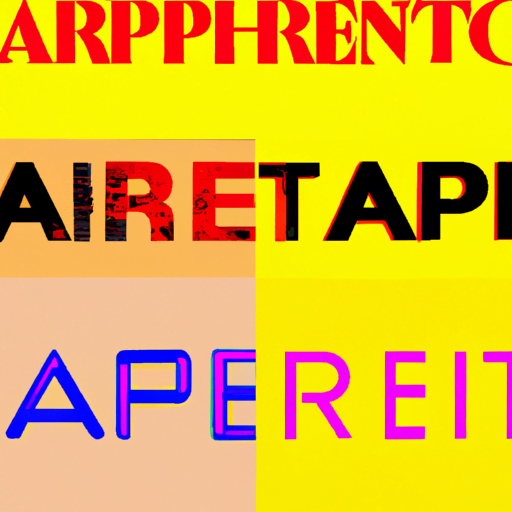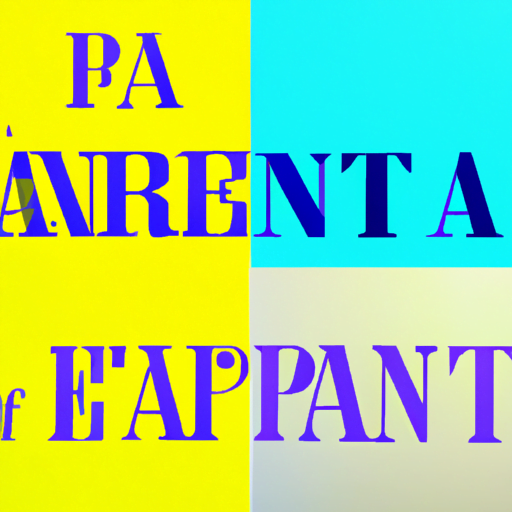
-
Table of Contents
- Typography as Art: Experimental Font Design
- The Intersection of Typography and Art
- The Impact of Experimental Font Design
- Innovative Approaches in Experimental Font Design
- 1. Handcrafted Fonts
- 2. Variable Fonts
- 3. Experimental Letterforms
- Case Studies: Experimental Fonts in Action
- 1. “Bauhaus” Typeface
- 2. “Gotham” Typeface
- 3. “FF Meta” Typeface
- Conclusion
Typography as Art: Experimental Font Design

Typography is an essential element of design that has the power to evoke emotions, convey messages, and create a unique visual experience. While traditional fonts serve their purpose, experimental font design pushes the boundaries of creativity and challenges the norms. In this article, we will explore the world of experimental font design, its impact on art and design, and the innovative approaches used by designers to create captivating and unconventional typefaces.
The Intersection of Typography and Art
Typography, at its core, is the art and technique of arranging type to make written language legible, readable, and visually appealing. It has long been recognized as a form of art, with its roots dating back to the invention of movable type in the 15th century. However, experimental font design takes typography to a whole new level, blurring the lines between art and design.
Experimental font design embraces the idea that typography can be more than just a means of communication; it can be a form of self-expression and a medium for artistic exploration. By pushing the boundaries of traditional type design, experimental fonts challenge our preconceived notions of what letters should look like and how they should be arranged.
The Impact of Experimental Font Design
Experimental font design has a profound impact on various fields, including graphic design, advertising, branding, and even fine art. Here are some key ways in which experimental fonts have influenced these industries:
- Breaking the Mold: Experimental fonts break away from the standardized and predictable typefaces commonly used in design. They introduce new visual elements and unconventional letterforms that capture attention and create a unique brand identity.
- Enhancing Creativity: By exploring new typographic possibilities, experimental fonts inspire designers to think outside the box and push their creative boundaries. They encourage experimentation and innovation in design projects.
- Evoking Emotions: Experimental fonts have the power to evoke specific emotions and set the tone for a design. Whether it’s a playful and whimsical font or a bold and edgy typeface, the choice of font can greatly influence how a message is perceived.
- Creating Visual Hierarchy: Experimental fonts can be used to create a visual hierarchy within a design. By varying the size, weight, and style of the type, designers can guide the viewer’s attention and emphasize important information.
Innovative Approaches in Experimental Font Design
Experimental font designers employ various techniques and approaches to create captivating and unconventional typefaces. Here are some notable examples:
1. Handcrafted Fonts
Handcrafted fonts are created by designers who meticulously draw each letterform by hand, resulting in unique and organic shapes. These fonts often have a raw and imperfect quality that adds a human touch to the design. Handcrafted fonts can be used to evoke a sense of authenticity and craftsmanship.
2. Variable Fonts
Variable fonts are a relatively new development in typography that allow for dynamic and responsive typefaces. Unlike traditional fonts, which are limited to a fixed set of styles, variable fonts can seamlessly transition between different weights, widths, and other attributes. This flexibility opens up new possibilities for designers to create fluid and adaptable typography.
3. Experimental Letterforms
Experimental fonts often feature unconventional letterforms that challenge our perception of what a letter should look like. Designers may distort, deconstruct, or rearrange the basic elements of a letter to create visually striking and thought-provoking typefaces. These experimental letterforms can be used to convey abstract concepts or add a sense of intrigue to a design.
Case Studies: Experimental Fonts in Action
Let’s take a look at some real-world examples of how experimental fonts have been used to create impactful designs:
1. “Bauhaus” Typeface
The “Bauhaus” typeface, inspired by the iconic German art school, is a prime example of experimental font design. It features geometric shapes, asymmetrical letterforms, and a minimalist aesthetic. This font captures the essence of the Bauhaus movement and has been widely used in modernist design projects.
2. “Gotham” Typeface
The “Gotham” typeface, created by designer Tobias Frere-Jones, is a contemporary font that combines elements of both traditional and experimental design. It features clean lines, subtle variations in stroke width, and a sense of geometric precision. “Gotham” has become a popular choice for branding and editorial design due to its versatility and modern appeal.
3. “FF Meta” Typeface
The “FF Meta” typeface, designed by Erik Spiekermann, is known for its distinctive letterforms and attention to detail. It combines elements of traditional serif and sans-serif fonts, resulting in a unique and highly legible typeface. “FF Meta” has been widely used in various design applications, including signage, print media, and digital interfaces.
Conclusion
Experimental font design pushes the boundaries of traditional typography and challenges our perception of what letters should look like. By embracing unconventional approaches and innovative techniques, designers create captivating and thought-provoking typefaces that have a profound impact on art, design, and visual communication.
Experimental fonts break away from the standardized and predictable, allowing for greater creativity, emotional impact, and visual hierarchy. Handcrafted fonts, variable fonts, and experimental letterforms are just a few examples of the innovative approaches used in experimental font design.
Real-world case studies, such as the “Bauhaus,” “Gotham,” and “FF Meta” typefaces, demonstrate the power of experimental fonts in creating impactful designs and establishing unique brand identities.
In conclusion, experimental font design is a dynamic and evolving field that continues to inspire and challenge designers. By embracing experimentation and pushing the boundaries of typography, we can create truly unique and captivating visual experiences.
